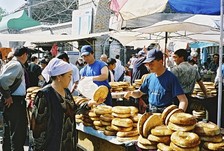This post originally appeared on the World Development Report 2011 blog.
Osh was a bustling, dynamic border town when I first visited Kyrgyzstan a decade ago. Today news reports describe a city devastated by killing, burning and pillage. I can only imagine the huge market place - one of the biggest in all of central Asia - gutted and forlorn.
Many Uzbeks have fled or cower in what's left of their homes. Traders are off the streets. The border to Uzbekistan, just down the road, is closed as are the bakers' stalls selling delicious rounds of bread. But saddest of all, the complicity among the many ethnic groups that rubbed shoulders on the streets of Osh appears to have been shattered.
From Almaty and Bishkek to Dushanbe and Samarkand, I was struck by the way people from so many ethnic backgrounds seemed to get on so well.
After independence in the early 1990s, there was a greater premium placed on being Kazak in Kazakhstan, Kyrgyz in Kyrgyzstan and so on in the other 'stans. Some people saw this as normal; others as ominous. But what I observed on several visits to the region were people of Russian, Armenian, Korean or Tartar descent strolling arm in arm with people of Uzbek, Kyrgyz, Tajik and Uyghur origin.
The Russian empire seemed to me to have done a better job of integrating diversity than the European imperial powers in Africa and Asia who left behind stiff class and ethnic divisions that have dogged many of them for the past half century.
My reading of social relations in Central Asia may be anecdotal but what I saw convinced me that whatever other problems these countries might face in the transition from central planning and socialism to independence and free markets, inter-ethnic tensions would not be a complicating factor. On the contrary, their multi-culturalism looked like a valuable asset in the globalized world of which they were now a part.
I was perhaps mistaken. Behind the personal affinities I observed on the streets of Central Asia, stress factors were accumulating. Tajikistan is still recovering from the bitter civil war it went through just after independence.
Elsewhere, successor regimes entrenched their positions. Kyrgyzstan was more volatile. The Tulip Revolution in 2005 toppled the regime while the most recent violent events left many dead on the streets of Bishkek and drove the prime minister into exile. Now Osh, the second city, has been devastated.
Our analysis of the causes of violent conflict suggests it is not the result of a single factor. Rather, it is the accumulation of stresses that make a country increasingly prone to conflict. The media has focused on the ethnic divide between the majority Kyrgyz and the minority Uzbeks in Osh that seems to have been whipped up by political interests as an extension of the confusion in Bishkek.
The full explanation of the breakdown of relations in Osh is undoubtedly more complicated and includes stresses caused by poverty, inequality, and corruption as well as political manipulation and the settling of scores. Ethnicity may have played a part but the region's history of inter-communal affinity offers a glimmer of hope for the future.
NICHOLAS VAN PRAAG manages the communications and advocacy program for the next World Development Report (WDR2011).
